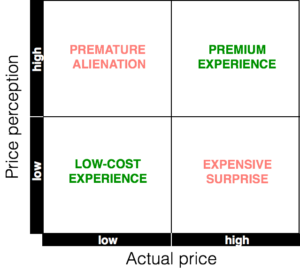Numerous research studies demonstrate that in many categories, price perception plays as significant a role as the actual price itself. In other words, whether customers perceive a brand as cheap, expensive or mid-range has a major impact on their purchasing decisions. One might assume that having a consistent pricing strategy is sufficient to position a brand correctly in consumers’ minds. However, this alone is not enough – price positioning must also be reinforced through other means.
Today we are analysing four scenarios, summarized in the matrix below: two in which price perception aligns with actual price and two where customers perceive the price as higher or lower than it really is.
Price perception / actual price matrix

Low-cost experience
This is the first scenario, in which the actual price and its perception are aligned. Represented in the bottom-left quadrant of the matrix (“low-cost experience”), a brand offers low prices and successfully builds an image that reinforces affordability.
However, low prices alone are not enough to establish this perception. Several factors must be in place to convince consumers that a brand is inexpensive. The most important ones include branding assets (logo, colours, fonts, design style, packaging, audio-branding, etc.), messaging (consistently reminding customers of affordability) and tone of voice (ensuring the brand does not appear too aspirational or exclusive, as this could undermine its affordability message).
Brands that have successfully implemented this strategy include Walmart, Lidl, McDonald’s, Ryanair and economy private labels.
Premium experience
The second aligned scenario (“premium experience”) is represented in the top-right quadrant of the matrix. Here, a brand charges high prices and has successfully built a premium image. As with the “low-cost experience”, simply setting high prices is not enough – consumers must associate the brand with premium value.
Brands that follow this strategy include Mercedes-Benz, British Airways, Apple, Whole Foods Market and HBO, and luxury brands in general.
Expensive surprise
The “expensive surprise” scenario occurs when a brand is perceived as offering low prices but, in reality, follows a premium pricing strategy. Depending on the category, this mismatch can be beneficial or problematic.
In product categories where consumers do not closely analyse prices, simply believing something is affordable may be enough to drive purchases. Many retailers apply this approach – building a low-cost brand image while charging premium prices for products that customers buy less frequently.
In categories where consumers scrutinise prices, this inconsistency can lead to frustration. Customers expecting affordability may be negatively surprised and choose a competitor instead. Brands in this situation can either adjust pricing to match consumer expectations or align brand messaging with a premium image to justify higher prices. In one of our previous posts, we wrote about the steps that a company needs to take in order to build a more premium brand image.
Several brands have faced this challenge. Samsung, Huawei and LG, for example, were once perceived as low-cost brands but have since shifted their strategy, introducing high-quality products with premium price tags. This transition created a temporary mismatch between their new positioning and consumer perceptions, requiring significant investment to realign expectations.
A related point to consider is that repositioning a brand from low cost to premium is a long-term process, often taking years and requiring a substantial budget to successfully reshape consumer perceptions.
Premature alienation
The final scenario, “premature alienation”, occurs when a brand has a premium image, leading consumers to expect high prices, even though the brand actually offers low prices. At first glance, one might assume this is a favourable position, as consumers would be positively surprised by great value deals. However, this is often not the case.
Consumers expecting high prices may never check the actual price, assuming the brand is unaffordable. As a result, brands may alienate price-conscious consumers who could afford the product but never consider it due to its premium perception.
This issue is commonly seen with mid-range brands attempting to differentiate themselves through a more aspirational image. While this can attract premium-seeking customers, it may also discourage budget-conscious shoppers. However, some brands benefit from this perception gap, particularly luxury brands offering more affordable product lines or the entire category of so-called affordable luxury (e.g., Coach, Kate Spade or Michael Kors).
Each of these scenarios can be a commercially valid business strategy. However, in the long run, the two scenarios where price perception does not align with actual price are more difficult to manage. Regardless of which strategy a brand follows, ongoing competitive analysis and brand measurement are essential to ensuring that price perception is intentionally shaped and reinforced.
If you need help with research or want to hire Magda for a strategy project, email her at magda@brandstruck.co
To subscribe to our newsletter, simply email your address to brandstruck@brandstruck.co with the subject line ‘Newsletter’.
Magda Adamska is the founder of BrandStruck.
https://www.linkedin.com/in/magda-adamska-32379048/
BrandStruck is the only online database of brand strategy case studies.
BrandStruck’s mission is to empower brand builders worldwide with the best brand strategy practices and insights, showcased through 250+ case studies of the world’s most admired brands.
